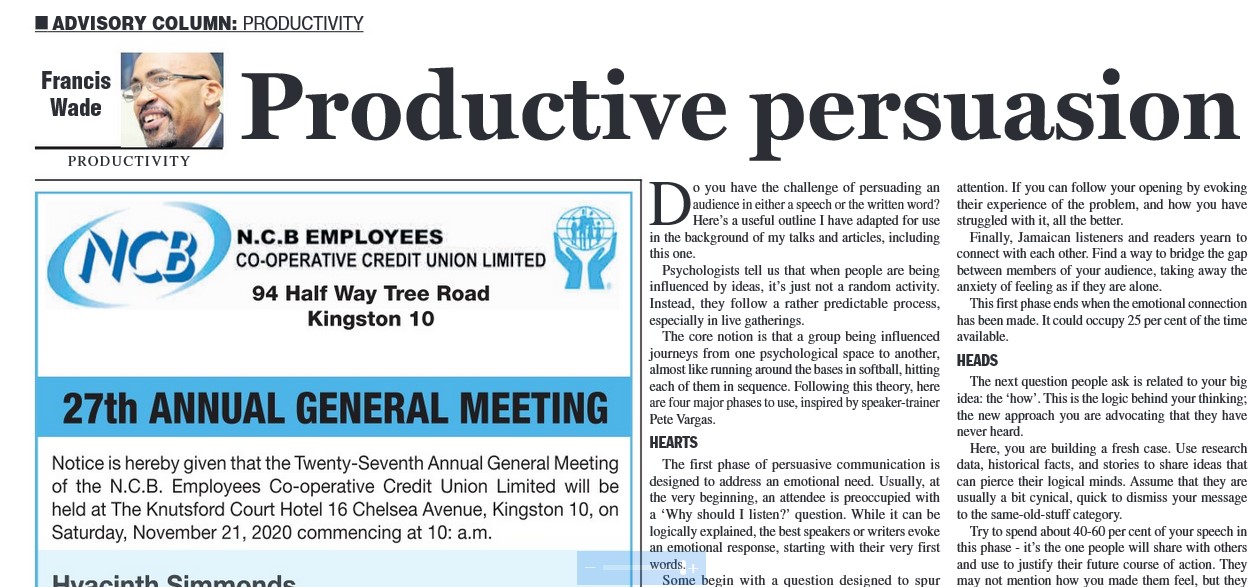Do you have the challenge of persuading an audience in either a speech or the written word? Here’s a useful outline I have adapted for use in the background of my talks and articles, including this one.
Psychologists tell us that when people are being influenced by ideas, it’s just not a random activity. Instead, they follow a rather predictable process, especially in live gatherings. The core notion is that a group being influenced journeys from one psychological space to another, almost like running around the bases in softball, hitting each of them in sequence. Following this theory, here are four major phases to use, inspired by speaker-trainer Pete Vargas.
Hearts
The first phase of persuasive communication is designed to address an emotional need. Usually, at the very beginning, an attendee is preoccupied with a “Why should I listen?” question. While it can be logically explained, the best speakers/writers evoke an emotional response, starting with their very first words.
Some begin with a question designed to spur curiosity. Notice that I used this approach in this article; it happens to be the one I use most often. Others give a startling statistic or quote. A few are brave enough to tell stories.
Unfortunately, too many stammer out irrelevant pleasantries to “break the ice”: thanking various people, introducing themselves, dropping anecdotes. They mistakenly believe that it’s impolite to start with a bang.
Yet, this is the best moment to make a heart-to-heart connection, before phones take away people’s attention. If you can follow your opening by evoking their experience of the problem, and how you have struggled with it, all the better.
Finally, Jamaican listeners and readers yearn to connect with each other. Find a way to bridge the gap between members of your audience, taking away the anxiety of feeling as if they are alone.
This first phase ends when the emotional connection has been made. It could occupy 25% of the time available.
Heads
The next question people ask is related to your Big Idea – the “how”. This is the logic behind your thinking – the new approach you are advocating that they have never heard.
Here, you are building a fresh case. Use research data, historical facts, and stories to share ideas that can pierce their logical minds. Assume that they are usually a bit cynical: quick to dismiss your message to the “same-old-stuff” category.
Try to spend about 40-60% of your speech in this phase – it’s the one people will share with others and use to justify their future course of action. They may not mention how you made them feel, but they will remember data such as the percentages I have quoted in this article.
This phase ends when their heads are nodding with understanding, showing they are ready to move on.
Hands
Arguably, your call to action (which takes place in this phase) is the most practical part of your communication. Here, you appeal to your audience to act to fulfill the promise of your Big Idea.
As such, this is not the time to be subtle or obtuse. Instead, create a picture of their future selves and ask them to make a concrete, visible commitment. It could be an altar call, a book purchase, a website download or something that doesn’t involve you at all, such as a sequence of steps.
Once they have been asked to act, you have set the stage for a powerful ending.
Hearts
The final 10% is a return to emotions. This is where you can continue a personal story or ask them to envision the person they’ll be once they take action. If you are able to create a connection to the feelings evolved at the start, even better.
The point here is to summon the emotional commitment needed to be successful going forward. After all, you are setting them loose to try your Big Idea in the real world full of resistance, resignation and cynicism – even if it’s their own. They’ll need to be strong to avoid the friction and distractions involved with the introduction of anything new.
Consider this to be a serious challenge. At the heart of your need to persuade should be an authentic commitment to make a life-changing difference. As someone who has stepped up, hold yourself accountable and be a contribution.
In other words, don’t commit the error of “just” giving a “small speech” or a “few remarks”. Every time you stand in front of a microphone, or put pen to paper, you have a sacred duty. You are not just a noisemaker.
Instead, honour your wildest dreams in which your words help people transform their lives, even if you’re only delivering a wedding toast. After all, you only need a single person to respond postively to know that it was worth the effort.

